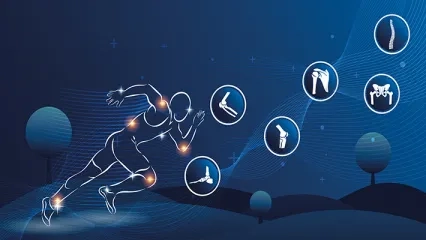Alo Yeditepe
Alo Yeditepe
Hip Osteoarthritis and Hip Prosthesis
Yeditepe University Hospitals Orthopedics and Traumatology Specialist Prof. Dr. Hasan Bombacı answered questions about Hip Osteoarthritis and Hip Prosthesis.
What is Hip Osteoarthritis?
Hip osteoarthritis is the name given to arthrosis of the hip joint among the people. In other words, deterioration of the structure of the hip joint due to degeneration or wear of the hip joint cartilage, loss of normal physiological lubricity, and range of motion of the joint are called hip osteoarthritis.
Why Does Hip Osteoarthritis Occur? What are the Causes?
Hip osteoarthritis can occur for various reasons. The first of these is trauma. In the event of an accident, when the hip joint is strained or a fracture occurs, the surface of the hip joint may deteriorate, and damage may occur. As a result, the joint becomes disorganized and arthrosis, that is, osteoarthritis, occurs.
Another important reason is the biomechanical disorders of the hip. Diseases that come from childhood and disrupt the biomechanical balance of the hip joint also cause arthrosis in the hip. Examples include developmental hip dislocation sequelae or diseases that disrupt hip joint nutrition seen in childhood.
Another disease that disrupts the hip joint is a rheumatic disease that involves the hip. Apart from these, some blood and hormonal diseases, AIDS, and alcoholism can be listed among the reasons that disrupt the nutrition of the hip joint in the middle and advanced ages. In these cases, the resistance of the hip bone, whose nutrition is impaired, decreases, the joint face collapses, the surface deteriorates, and arthrosis may develop as a result of this deterioration.
What are the Symptoms of Hip Osteoarthritis?
The most important symptom of hip osteoarthritis is pain in the groin area of the hip. First of all, this condition occurs with prolonged walks. But the pain then begins to appear at shorter distances when walking. Although the pain that occurs with movement at first goes away when you rest, it becomes a constant pain later. In this process, the movements of the hip begin to be restricted. In particular, the movements of pulling the hip towards the abdomen or turning it inward are primarily restricted. An increasing limp appears in the patient. But the most important and first symptom of hip arthrosis is pain.
Can Hip Osteoarthritis Confuse Pain With A Different Problem? Is There a Significant Pain in Hip Osteoarthritis?
The pain is mild at first. During exercise, it is seen in difficult walks. But hip pain can have other causes besides osteoarthritis. For example, in the early stages of hip avascular necrosis, which can turn into hip arthrosis, pains occur in the hip region even before arthrosis has developed. In structural disorders of the hip joint, which is described as "hip joint compression syndrome", pain may occur in certain movements of the hip due to the local incompatibility in the joint. Apart from all these, there may also be pains caused by the muscles around the hip, regardless of the hip joint. For example, tears and edema on the front of the hip due to the overloading of some muscle groups and tendons can also cause such pain. However, in each of these disorders, the character of the pain varies, and they agree with the examination, and the doctor can make the distinction.
How is Hip Osteoarthritis Diagnosed?
First of all, examination is very important for the patient who comes with pain. After the examination, an X-ray examination is performed first. On X-ray, irregularities in the hip joint and accordingly deformities in the hip joint can be easily seen. Although X-rays are sufficient in the final stage of arthrosis, MRI imaging is also necessary to see developing or beginning cartilage damage in patients with hip pain. For example, the first symptoms of hip avascular necrosis, which is one of the causes of hip arthrosis, can only be seen on MRI. Similarly, soft tissue damage due to "hip joint compression syndrome" can also be seen with MRI. Computed tomography can also be used in very special cases.
How is Hip Osteoarthritis Treated?
In a patient with hip joint pain, some of the causes can be treated or at least delayed if they can be detected before the hip goes to arthrosis. In some cases, weight reduction and physical therapy may be partially beneficial. However, even at an early stage, surgical intervention is often necessary. Although osteotomy (bone shaping adjustments made to correct bone axis disorders and balance the load distribution) surgeries, which were applied much more frequently in the past, still have a place in treatment today. Moreover, the technical possibilities that have developed recently have enabled arthroscopic applications of the hip joint to be used more frequently. However, in advanced hip arthrosis, total hip replacement is the leading treatment method. The developing technology has also increased the durability of prostheses. However, it should always be kept in mind that prosthetic surgery is an irreversible surgery. However, it is possible to achieve very successful results in the early and middle periods with hip replacement surgeries that have been successfully applied with appropriate indication.
When Does Hip Osteoarthritis Surgery Become Mandatory?
In these patients, age is of primary importance for surgery. If possible, hip protective procedures should be preferred at an early age. However, the prosthesis is a very good solution in old age. When it is said that surgery is required, the most important criterion is the severity of the patient's pain. If the patient cannot continue his daily life comfortably, and most importantly, if resting pains have started, if the sleep pattern due to pain is disturbed, surgery is inevitable in these cases. In some patients, the limitation of movement to a very advanced stage may become a cause of surgery because it will cause problems in the knee and waist. Again, the age of the patient should be taken into consideration.
Which surgical methods are most preferred in hip surgery?
The surgical treatment method in hip surgery is decided according to the current problem. If hip arthrosis is in the early stage, that is, in the stage of cartilage damage in the hip joint called "chondromalacia", arthroscopic methods or osteotomy (bone/deformity correction) surgeries are generally preferred. But, if the damage has progressed too far, such surgeries will no longer be useful. In this case, taking into account the medical indications, conditions such as the age of the patient, the condition of the pain, resting pains, and the effect on the quality of life are also evaluated and prosthetic surgery is applied.
In particular, how does the postoperative process progress?
Hip prostheses are very gratifying surgeries and very fast results can be obtained. It is indeed a surgery that provides the patient with a lot of comfort in the early and medium periods. The prostheses to be used in the surgery are of two different types. According to the type of prosthesis used, postoperative recovery and what needs to be considered differ. One of these two types of prostheses is cemented and the other is cementless. While cemented prostheses can load the hip earlier, there are opinions that cementless prostheses prefer to load a little later. In both prostheses, the patient can step on his/her feet and walk shortly after the surgery. Depending on the range of motion before surgery, it can continue its daily life quite well. In general, patients can walk without a cane for about two to three months. However, since some additional procedures will be required in patients with hip dislocation sequelae, these periods may be prolonged.
How long is the life of a hip replacement? How long does the prosthesis last?
The life of hip prostheses may also vary depending on the prosthesis to be made. The most important thing that determines the life of hip prostheses here is the interface. Interfaces were previously made with a very specially developed material called polyethylene. Later, however, products made of ceramics and their derivatives began to be used. The durability and life of both polyethylene and ceramic surfaces have increased considerably compared to the first prostheses. Studies on this subject continue very intensively. Today, the longest life in prostheses is achieved with ceramic-ceramic and ceramic-enhanced cross-linked polyethylene surfaces. In some of the prostheses currently used, durability can be mentioned for more than twenty years.
If we look at the patients who underwent prosthetic surgery, both young and elderly, what are your suggestions?
The most important thing that the patient who has undergone a prosthesis should pay attention to is to avoid trauma. Because the elasticity of the prosthesis and bone is different, there may be fractures around the prosthesis during any trauma. Treatment of these fractures can sometimes reduce the benefit that the patient receives from prosthetic surgery. Patients should avoid trauma to the hip area or risky jobs and activities that require falling and jumping from a height. Apart from this, it is appropriate to avoid moving the hip abnormally and forcing the ends of the hip movement. However, there is no harm in living in accordance with the flow of daily life and using the prosthetic joint as necessary.
About
Faculty and Year of Graduation:
İstanbul Faculty of Medicine, 1986
”
See Also
- What are Hip Joint Diseases? Causes and Treatment
- Robotic Hip Replacement Surgery
- What is Hallux Rigidus (Stiff Big Toe/Toe Arthritis)? Symptoms and Treatment
- What is Hallux Valgus (Bunion)? How is it Treated?
- Ergonomics in Automobiles Prevents Accidents
- Walking and Returning to Social Life After Knee Replacement Surgery
- What Are the Advantages of Robotic Knee Replacement Surgery?
- Robotic Knee Prosthesis Surgery
- The Usage Area of Robotic Surgery Expands in Orthopedic Surgeries
- Higher Risk of Anterior Cruciate Ligament and Ankle Injury in Female Athletes
- Spinal Fractures
- Big Toes Can Be A Big Problem!
- Not Only Athletes Suffer from Meniscus Tears!
- Mistakes While Swimming Can Cause Shoulder Pain
- Myths About Fractures
- The First Onset of Pain in Cartilage Damage in the Knee Should Not Be Overlooked
- Sports Injuries
- 8 Common Misconceptions About Sports Injuries
- Knee Arthritis
- Knee Pain
- Treatment of Knee Arthrosis Varies According to the Person
- A Lack of Attention to Sports Injuries in Children May Affect Their Development
Alo Yeditepe




